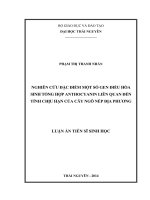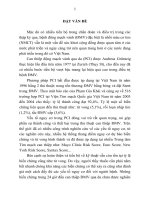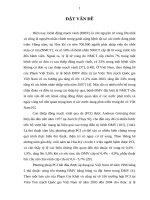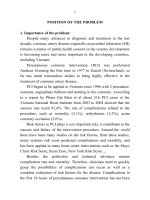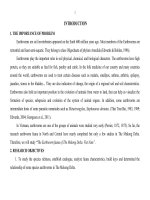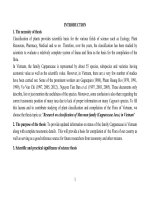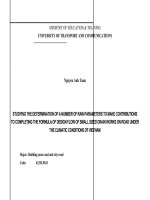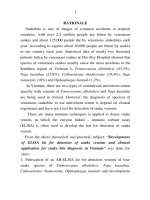nghiên cứu đặc điểm một số biến chứng trong 24 giờ đầu can thiệp động mạch vành qua da tại viện tim mạch quốc gia việt nam bản tóm tắt tiếng anh
Bạn đang xem bản rút gọn của tài liệu. Xem và tải ngay bản đầy đủ của tài liệu tại đây (222.18 KB, 26 trang )
POSITION OF THE PROBLEM
1. Importance of the problem:
Despite many advances in diagnosis and treatment in the last
decade, coronary artery disease especially myocardial infarction (MI)
remains a matter of public health concern in the country development
is becoming more and more important in the developing countries,
including Vietnam.
Percutaneous coronary intervention (PCI) was performed
Andreas Gruntzig the first time in 1977 in Zurich (Switzerland), so
far has made tremendous strides to bring highly effective in the
treatment of coronary artery disease.
PCI began to be applied in Vietnam since 1996 with 2 procedure:
coronary angioplasty balloon and stenting in the coronary. According
to a report by Pham Gia Khai et al about 516 PCI cases at the
Vietnam National Heart Institute from 2003 to 2004 showed that the
success rate reach 92,4%. The rate of complications related to the
procedure, such as mortality (5,1%), arrhythmias (1,2%), acute
coronary occlusion (3,6%).
Risk factors in PCI plays a very important role, it contributes to the
success and failure of the intervention procedure. Around the world
there have been many studies on the risk factors, from these studies,
many systems risk score predicted complications and mortality, and
has been applied in many heart center interventions such as the Mayo
Clinic Risk Score, Score Euro, New York Risk Score
Besides the perfection and technical advances remain
complication rate and mortality. Therefore, clinicians need to quickly
grasp the possibilities of complications can occur as well as a
complete evaluation of risk factors for the disease. Complications in
the first 24 hours of percutaneous coronary intervention has not been
1
studied systematically in Vietnam. So we conducted a research topic
“Study on the characteristics some complications of percutaneous
coronary intervention during the first 24 hours at Vietnam Heart
Institute” has been carried out with the following objectives:
1. To study the rate, characteristics common complications and
deaths during the first 24 hours of percutaneous coronary intervention.
2. Identified several risk factors related complications and
mortality in the first 24 hours of percutaneous coronary intervention
through a scale of Mayo Clinic Risk Score and New York Risk Score.
3. To initially assess the points of risk to predict about
complications and deaths in PCI by applying the scale Mayo Clinic
Risk Score and New York Risk Score.
2. Contributions of this thesis:
- Shows some common complication rates in the first 24 hours of
PCI in Vietnam.
- Identify risk factors predict complications or death can occur in
PCI.
- Initial application values the scale Mayo Clinic Risk Score and
New York Risk Score to develop forecasts the risk of complications
and deaths in PCI.
PRESENTATION OF THE THESIS
The thesis comprises 118 pages, repartitioned in 4 chapters,
dealing with 2 pages for Position of the Problem, 30 pages for the
Overview, 21 pages for the Subjects and Research Method, 30 pages
for the Study Results, 30 pages for the Discussion, 2 page for the
Conclusions, and 1 page for the Recommendations. There are 65
tables, 7 charts, 10 images, 1 diagram of the study design. There are
154 references, including 26 Vietnamese documents and 128 English
documents.
2
CHAPTER 1
OVERVIEW
1.1. Percutaneous coronary intervention (PCI)
A method of expanding coronary artery blockages or injured by
balloon, then put the stent in the location of lesion, with the purpose
of restoration of coronary circulation.
1.1.1. Technical summary coronary balloon angioplasty
Balloon diameter ratio versus selected coronary artery diameter is
1:1. Coronary artery diameter was assessed by comparing the size of
the target vessel catheter (6F = 2 mm).
Balloon is pushed under the wire to the target lesion. Coronary
angiography to determine the exact position of the balloon in injury,
pump by pump the balloon up slowly until the pressure expander
balloon completely from 10-60 seconds. Coronary angiography to
check. If patient stable condition, the level of residual stenosis <
30%, achieved TIMI 3 flow and no complications, the instrument is
drawn out and coronary angiography for the last time at the end.
1.1.2. Technical summary Stent placed in a coronary artery
Size of balloon and Stent was selected in proportion: diameter of
balloon in Stent /diameter of normal coronary artery segments = 1.1.
Dilated coronary artery lesions with the balloon in front to reduce
the risk of vascular dissection, and helps ease stent placed, then the
balloon is determined Stent pump can be fully dilated, and the
procedure may look apparent location of the original lesion. In the
case of multiple stent placed in one coronary artery stent should be
placed in the most remote locations injury front end damage to
government.
3
1.2. The common complications in percutaneous coronary
intervention
1.2.1. The complications in coronary artery
* Peri-procedural myocardial infarction: defined as an increase
in the biomarker (troponin above the 99% increase of the normal
upper limit), the CK or CK-MB increase ≥ 3 times the upper limit of
normal. Most of the major mechanisms of myocardial damage during
the procedure due to distal embolization and side-branch occlusion.
Other causes can also cause damage to the heart muscle as coronary
dissection, coronary perforation, thrombosis, no reflow or slow flow.
* Side-branch occlusion: study of Páez L. et al with the ratio is
12% of direct stenting. According Kralev S. et al: intervention side
branch lumen diameter ≤ 0,6 mm and small interfering narrow hole
in the side branch elements threaten to side branches.
* Distal embolism: ballooning or stenting placed at the culprit
lesion thrombus or plaque peeling distal embolization. High risk of
procedures for bridging veins are more fragile plaque. Distal
embolization leads to clogging of blood vessels, causing slow flow or
no reflow thereby increasing myocardial necrosis.
* Coronary artery perforation: Stephen G. Ellis et al divided
into 3 coronary artery perforation types. Type I: the circuit has cracks
but not leach contrast out of circuit, type II absorbed less contrast
into the myocardial or pericardium, type III: contrast escaped through
holes with a diameter > 1 mm into the pericardial cavity or
ventricular chamber.
The majority of coronary artery perforation during the procedure
due to mechanical mechanisms: sharp instruments like end of the
wire into the circuit puncture. The size of the balloon or stent is too
large compared to the size lumen. Cut out a lot of different plaque
4
attached by drilling and cutting equipment, injure the endothelium
and vascular tear crack formation.
* Coronary artery dissection: classification system coronary
artery dissection of National Heart Lung and Blood Institute (NHLBI)
according to the level of A, B, C, D, E and F. Procedure widening the
cracks causing intravascular plaque and endothelium separated thus
forming a local snake cup. Mild dissection: the endothelium but not
torn medial. Complex dissection: medial torn by the forces of
intervention devices, thus forming stretch or road split snake twisting,
line integral intravascular contrast material or residual stenosis > 50%.
* Acute coronary artery obstruction: force stretches of balloon
as filter for the endothelium, the endothelium and medial crack formed
capillary membrane separator, cyclone separator spread obstruct the
lumen. When the endothelium interrupted crack, revealing layers of
collagen causes activation of coagulation factors and organizational
factors, together with the accumulation of platelet deposition and
thrombus formation results, eventually leading and to reduce the flow
of blood stasis. In addition, a number of vasoactive mediators and anti-
inflammatory also liberated cause vasospasm in place to form clots.
* No reflow phenomenon: Eric R. Bates et al 1986 study and
describe the no reflow phenomena not show a weakening downstream
flow in the coronary arteries. The main culprit of the no reflow
phenomenon is due to the behavior of thrombosis and plaque clog peeling
or spasm circuits, particularly circuits with a diameter < 200 µm.
1.2.2. The medical complications
* Reperfusion syndrome: reperfusion injury is related to the
heart muscle, blood vessels, and/or electrical dysfunction of the heart
muscle physiology, due to the recovery of coronary arterial flow to
the ischemic myocardial tissue was before. The expression of
ischemia and reperfusion injury include:
5
- Arrhythmia.
- Dysfunction of microcirculation.
- Myocardial stunning.
* Arrhythmia cardiac in procedure: pathophysiological
mechanisms causing cardiac arrhythmia due to the following factors:
- Anemia and myocardial reperfusion.
- Intensity vagus.
- Contrast.
- The measure of coronary flow reserve.
* Contrast Induced Nephropathy (CIN): CIN is the deterioration of
renal function occurred within 48 hours after the patient is using contrast.
After contrast in the body, increased serum creatinine levels ≥ 44,2 µ mol
(≥ 0,5 mg/dl) or ≥ 25% increase in the first 24 hours and reached peak
levels from 48-96 hours. Renal function returned to normal or near normal
within 1-3 weeks.
1.2.3. Complications at the access arterial
- Bleeding and hematoma at the access of radial artery.
- Obstruction of the radial artery and hand ischemia.
- Bleeding and hematoma at the access of femoral artery.
- Assume femoral artery aneurysm.
- Retroperitoneal bleeding.
1.3. The risk factors in percutaneous coronary intervention
* The nature of the urgent intervention and elective intervention:
The nature and level of the disease coronary in urgent
intervention and elective intervention that very different, thus
affecting the results of the procedure.
* Patient factors: consists of 2 main factors: older patients and
women.
* Element clinical and subclinical: including pathological
manifestations such as disorders of left ventricular systolic function,
6
cardiogenic shock, heart failure NYHA. In addition, the coexisting
illnesses such as diabetes and kidney failure.
* Pathological factors: including the nature and location of
coronary artery lesions as general disease left main, disease 3 branchs
and of chronic total obstruction coronary artery.
CHAPTER 2
SUBJECTS AND RESEARCH METHODS
2.1. Subjects
2.1.1. Selection criteria of patients: included 511 male and female
patients admitted to hospital emergency and inpatient hospitalization
at the Vietnam Heart Institute is divided into 2 groups:
- The group of patients diagnosed acute coronary syndrome,
indicated urgent percutaneous coronary intervention (urgent PCI).
- The group of patients diagnosed stable angina, indicated
percutaneous coronary intervention routine (elective PCI).
2.1.2. Exclusion criteria: those patients with the following characteristics:
- Being hematopoietic organ disease or coagulopathy.
- Acute liver failure.
- Just coronary angiography without intervention procedure.
- Procedure intervention for abnormal anatomy.
- Complications and death beyond 24 hours after procedure.
2.1.3. Indications for percutaneous coronary intervention
* Urgent PCI: including patients diagnosed:
- ST segment elevation acute myocardial infarction:
- Acute myocardial infarction without ST segment elevation and
unstable angina.
* Elective PCI: including patients diagnosed stable angina.
2.2. Method of study
7
2.2.1. Study design: prospective studies, cross-sectional descriptive,
longitudinal follow up within 24 hours from the start of procedure.
2.2.2. Steps of the processing
* The process of clinical examination, clinical testing preprocedure:
- Patients admitted to hospital emergency: clinical examination, such
as heart rate, blood pressure, pulmonary ran Cardiogenic shock, heart
failure NYHA, heart failure Killip. Electrocardiography, echocardiogram,
blood tests CK, CK-MB, CBC, coagulation basic electrolytes.
- Hospitalized patients: clinical examination admitted to hospital
as an emergency. Making electrocardiography, echocardiogram, blood
tests, stress tests, coronary CT 64 range.
* Process monitoring changes in procedure:
- Clinical: shortness of breath, chest pain, sweating, cold skin and
purple, heart rate, pulmonary ran Expression allergies: hives,
difficulty breathing, nausea.
- The equipments for monitoring changes in procedure:
monitoring system to measure arterial pressure continuously. System
continuous electrocardiography monitoring. Two light up the screen
with a camera connected circuit.
* Process monitoring of patients after the procedure:
- Clinical: chest pain, shortness of breath, cardiogenic shock, heart
rate, blood pressure, urine for 24 hours, marks on arterial access.
- Subclinical: blood tests: urea, creatinine, glucose, electrolytes,
CK, CK-MB, electrocardiography, echocardiography, heart-lung X
ray, abdominal ultrasound.
* Statistics complications and deaths in the first 24 hours of procedure:
* Statistical evaluation of the results and forecasts the risk of
complications and deaths:
8
- Apply Mayo Clinic Risk Score for statistical risk factors related
complications, and New York Risk Score for statistical risk factors
related to mortality.
- Assessment scores predicted the risk of complications and death.
2.2.3. The criteria used in the study
* Diagnostic criteria for coronary artery disease: including acute
myocardial infarction, unstable angina, stable angina.
* Diagnostic criteria for MI and MI area on the electrocardiographic:
* Indications for percutaneous coronary intervention: including
Urgent PCI and elective PCI.
* Criteria for evaluation of the results of the intervention
procedure: assessed by flow in the DMV according to the TIMI scale.
* Criteria for evaluation of a number of complications:
- Myocardial infarction.
- Coronary artery dissection.
- Perforation of the coronary
arteries.
- No reflow phenomenon.
- Reperfusion syndrome.
- Arrhythmia during the procedure.
- Contrast induced nephropathy.
* Criteria for evaluation of a number of risk factors:
- Cardiogenic shock
- Heart failure Killip.
- Heart failure NYHA.
- Left ventricular systolic function (EF) on
echocardiography.
- Hypertension.
- Diabetes mellitus.
* Criteria for evaluation of system risk factors: scale assessment
of risk factors for complications (Mayo Clinic Risk Score). Scale
assessment of risk factors for death (New York Risk Score).
2.3. Statistical analysis of data research
* Statistical analysis of data: data collected by the study, the
algorithm is treated by T-test to compare average, comparison of rate
by algorithm χ2 (Chi-Square test), calculated OR and confidence
9
interval estimates of OR to calculate risk. Data were analyzed using
SPSS 16.0 software. P value < 0,05 was considered statistically
significant.
* The risk scores predict complications and mortality in PCI: by
applying ROC curve chart. ROC curve represented the relationship
between sensitivity and specificity of the total score overall risk of
complications or mortality risk score. Each point on the ROC curve
coordinates corresponding to the frequency of true-positive
(sensitivity) on the vertical axis and the frequency of false positives
(1-specificity) on the horizontal axis. Accuracy is measured by the
area under the ROC curve. If the area = 1, the test is very good, if the
area = 0,5, the test is not valid.
CHAPTER 3
RESULTS
3.1. The rate and characteristics of complications and deaths
3.1.1. The rate of complications during coronary intervention
Monitored patients in 2 group PCI in the first 24 hours have
116/511 patients with complications (22,7%). Urgent PCI group had 81
patients with complications (30,2%), elective PCI group had 35 patients
with complications (14,4%). The rate of complications of urgent PCI
group (30,2%) was higher than elective PCI group (14,4%) with p <
0,001.
Table 3.5. Distribution of complication rate in the PCI
Complication None
Patient
s
Percentag
e
Patient
s
Percentag
e
10
Urgent
(n = 268)
81 30,2 187 69,8
Elective
(n = 243)
35 14,4 208 85,6
General
(n = 511)
116 22,7 395 77,3
3.1.2. The complications in coronary artery
* Coronary artery perforation and dissection:
Table 3.11. Characteristics of coronary artery perforation and
dissection
Process
and standards
Features
Perforation Dissection
Nature of PCI Elective Urgent Elective
Patients, percentage 1 (0,2%) 1 (0,4%) 4 (1,6%)
Lesions (ACC/AHA B A A and B
Type (Ellis) II - -
Type (NHLBI) A A and B
Procedure Stenting Stenting Stenting
Placement procedure LAD LAD LAD and RCA
Risk factors
High age (81 age),
disease 3 branchs,
left main disease,
chronic total
occlusion
Urgent PCI,
chronic total
occlusion
High age,
disease 3
branchs, left
main disease,
chronic total
occlusion
Risk score (MCRS)
14 6 7 - 12
Level of risk (MCRS) High Low Low - High
11
* No reflow phenomenon and distal embolism:
Table 3.12. Characteristics of no reflow phenomena and distal
embolism
Process
and standards
Features
No reflow phenomenon Distal embolism
Nature of PCI Urgent Elective Urgent
Patients, percentage 10 (3,7%) 4 (1,6%) 3 (0,6%)
Circumstances
Postballooning Stenting
Postballooning
Placement
procedure
LAD, Lcx and
RCA.
LAD and RCA.
Segment 1 of LAD
Image No flow No flow Image
"amputation"
Flow level
TIMI 0, 1 TIMI 0, 1
TIMI 0-1
Risk factors
High age (> 70
age). Urgent
intervention.
NYHA III-IV.
Disease 3
branchs.
Total occlusion.
High age (> 70
age).
Left main
disease.
Disease 3
branchs.
Total
occlusion.
Urgent PCI.
Total occlusion.
Thrombosis.
Risk score (MCRS)
6 - 10 4 - 11 5 - 6
Level of risk (MCRS)
Low - Medium
Very low -
Medium.
Low
3.1.3. The medical complications
* Reperfusion syndrome:
12
Table 3.14. Features reperfusion syndrome in procedure
Process and standards Features
Nature of PCI Urgent
Patients, percentage 37 (7,2%)
Procedure Thrombosis
Circumstances Postballooning
Symptoms, percentage Cardiac arrhythmias (13,8%), hypotension (11,6%),
chest pain (10,4%), shortness of breath (7,0%),
Risk factors Thrombosis, myocardial infarction
Risk score (MCRS) 6 - 10
Level of risk (MCRS) Low - Medium
* Rối loạn nhịp tim trong thủ thuật:
Table 3.15. Characteristics of arrhythmia in procedure
Process and
standards
Features
Nature of PCI Urgent Elective
Patients, percentage 37 (7,2 %) 13 (2,5%)
Circumstances
Postballooning Postballooning and
pumped the contrast
The type of
arrhythmia
Sinus bradycardia (1,6%),
sinus tachycardia (1,2%),
atrial fibrillation (0,4%),
atrial tachycardia (0,4%),
extrasystole ventricular
(1,6%), ventricular
tachycardia (1,8%),
ventricular fibrillation
(0,6%), atrial-ventricular
block level III (1,0%).
Sinus bradycardia (0,4%),
atrial fibrillation (0,6%),
atrial tachycardia (0,2%),
extrasystole ventricular
(0,6%), ventricular
tachycardia (0,6%),
ventricular fibrillation
(0,4%)
Risk factors
Total occlusion RCA
(thrombosis), procedure of
RCA
Heart failure NYHA III-IV,
procedure of RCA
Risk score (MCRS) 6 - 10 6
13
Level of risk (MCRS) Low - Medium Low
* Contrast induced nephropathy (CIN):
Table 3.18. Average serum creatinine levels at 2 time points
Circumstance
s
Creatinin
(µmol/l)
Preprocedure Postprocedure p
General
(n = 511)
X
± SD 99,09 ± 29,25 110,18 ± 42,97 < 0,001
Lowest-
Highest
46 - 292 52 - 407
CIN
(n = 40)
X
± SD 156,88 ± 58,43 226,38 ± 66,47 < 0,001
Lowest-
Highest
80 - 292 143 - 407
3.1.4. Complications bleeding - hematoma at the access arterial
Table 3.21. The rate of bleeding - hematoma at the access arterial
follow gender and age group
Features Male Femal
e
Genera
l
OR (95% CI) p
Bleeding Patients 1 7 8
25,3
Percentag
e
0,3 6,0 1,6
None Patients 394 109 503
Percentag
e
99,7 94,0 98,4
Age group
< 70 age
(n = 343)
Patients 0 4 4
Percentag
e
0 5,8 1,2
≥ 70 age Patients 1 3 4
Percentag 0,8 6,4 2,4
14
(n = 168) e
p > 0,05 > 0,05 > 0,05
15
3.1.5. The rate and characteristics of deaths
Tabe 3.23. Distribution of mortality in coronary intervention
Deaths No deaths OR
Patient
s
Percentag
e
Patient
s
Percentag
e
Urgent
(n = 268)
10 3,7 258 96,3
9,38
(1,19-
Elective
(n = 243)
1 0,4 242 99,6
General
(n = 511)
11 2,2 500 97,8
3.2. The risk factors related to complications
3.2.1. The system of risk factors related to complications
Table 3.31. The rate of risk factors related to complications
Risk factors
Complications None
Patient
s
Percentage Patient
s
Percentage p
Cardiogenic shock 15 100 0 0 <0,001
Killip III 9 50,0 9 50,0 <0,01
NYHA III-IV 17 32,1 36 67,9 >0,05
EF < 29% 18 46,2 21 53,8 <0,01
Renal failure 8 100 0 0 <0,001
Diabetes 16 24,2 50 75,8 >0,05
Hypertension 72 22,8 244 77,2 >0,05
Left main disease 10 30,3 23 69,7 >0,05
Disease 3 branchs 73 37,8 120 62,2 <0,001
Total occlusion 50 26,6 138 73,4 > 0,05
16
3.2.2. The system of risk factors related to deaths
Table 3.32. The rate of risk factors related to deaths
Risk factors
Deaths (n = 11) No deaths (n = 500)
Patients Percentag
e
Patients Percentag
e
p
Cardiogenic shock 9 60,0 6 40,0 <0,001
Killip III 2 11,1 16 88,9 <0,05
NYHA III-IV 7 13,2 46 86,8 <0,001
EF < 29% 8 20,5 31 79,5 <0,001
Renal failure 2 25,0 6 75,0 <0,05
Left main disease 4 12,1 29 87,9 <0,01
Disease 3 branchs 10 5,2 183 94,8 <0,001
Total occlusion 6 3,2 182 96,8 >0,05
3.3. Risk score predicted complications and deaths in coronary
intervention
3.3.1. Scores predicted the risk of complications according to Mayo
Clinic Risk Score
ROC curve with a cut point of the total risk score = 6,5
corresponding to sensitivity = 0,63 and specificity = 0,67. The risk of
complications in PCI is forecast when 1 patients with a total score ≥
6,5 to follow MCRS, the sensitivity of the cut point = 0,65 (65,0%)
and specificity = 0,67 (67,0%).
3.3.2. Scores predicted mortality risk according to New York Risk Score
ROC curve with a cut point of total risk score = 15,5,
corresponding to sensitivity = 1,0 and specificity = 0,96. The risk of
death in PCI is forecast when 1 patients with a total score ≥ 15,5 to
follow NYRS, with the sensitivity of the cut point = 1,0 (100%) and
specificity = 0,96 (96,0% ).
17
CHAPTER 4
DISCUSSION
4.1. The rate and characteristics of complications in the first 24
hours of procedure
4.1.1. The rate of complications during coronary intervention
There were 116/511 patients (22,7%). This result is almost
similar to the complication rate in the study of Mandeep Singh et al
(29,4%), when applied MCRS scale is 28,6%. Retrospective study of
H. Vernon Anderson et al from the ACC-NCDR data showed that the
difference between urgent PCI and elective PCI: complication rate in
urgent PCI higher complication rate in elective PCI with p = 0,0055.
The study results are almost similar to the results of our study:
the complication rate of urgent PCI was higher complication rate of
elective PCI. The risk of complications in urgent PCI was 2,6 times
higher compared with elective PCI. (OR = 2,57; 95% CI from 1,65 to
4,01 with p < 0,001).
4.1.2. The complications in coronary
* Coronary arterial perforation: coronary perforation occurred
in stenting at the segment 2 of left anterior discending. The degree of
perforation is type II (Ellis). The risk factors in this patient is said to
be the cause, such as advanced age (81 years old), disease 3 branchs,
narrow left main, complete obstruction of coronary, injury type B
(ACC/AHA). According to some authors about the causes of
coronary artery perforation in procedure may be due to the use of
balloon size ratio/lumen diameter. According Ajluni SC et al: balloon
ratio size/lumen diameter was 1,3 ± 0,3 coronary perforation rate
higher than the rate of balloon ratio size/lumen diameter was 1,0 ±
0,3 with p<0,001. According to Z. Rahman et al: use balloon size
18
ratio/ lumen diameter > 1,1 is coronary artery 2-3 times higher than
the rate used balloon size/lumen diameter <1,1 .
* Coronary arterial dissection: coronary arterial dissection
accounted for 0.9%, 2 patients had dissection type A and 3 patients
had dissection type B (NHLBI), 5 patients occurred in stenting after
balloon dilatation. The principal risk factors that may cause
dissection: 5 patients were aged > 70, 1 BN in urgent PCI. These
patients generally had disease left main, disease 3 branchs, complete
obstruction of coronary, this could be a major risk factor for
dissection. All 5 patients were dissected level A and B. Coronary
arterial dissection is a common complication in PCI, which kind of
dissection for C, D, E and F indicated surgery.
* No reflow phenomenon: 14 patients reveal no reflow
phenomenon (2,7%) during the procedure. This is a common
complication was transient. There are several risk factors that could cause
such advanced age (>70 years), have 10/14 patients with urgent PCI,
NYHA III-IV, disease left main, disease 3 branchs, complete obstruction
of coronary.
No reflow phenomenon sometimes occurs in the procedure, many
authors suggest that the behavior of thrombus and plaque clog peeling
or spasm of microvascular (microvascular with diameter < 200 µm).
* Distal embolism: monitoring 3 patients with distal embolism
during urgent PCI, accounting for 0,6%. Risk factors may be:
thrombosis, complete obstruction of coronary, this can cause distal
embolism. Complications occurred in stenting put at the segment 2 of
left anterior discending, image of coronary angiography express
"amputation" in distal vascular, achieving TIMI 0-1 flow.
Distal embolism are common complications in the procedure and
also was the risk of myocardial infarction, the detection and management
of this complication is timely safety measures and effective.
19
4.1.3. The medical complications
* Reperfusion syndrome: analyzing the results, we see
manifestations of the reperfusion syndrome decreased over time
myocardial infarction (chart 3.4). Many authors suggest that time related
MI pathophysiological mechanisms of reperfusion syndrome, which
highlights the role of myocardial metabolic changes: reperfusion after
myocardial ischemia can slow recovery of myocardial function.
* Arrhythmia in procedure:
- Arrhythmias in reperfusion syndrome: ECG monitoring during
the procedure, 37 cases have arrhythmias. Arrhythmias is due to
mitochondrial dysfunction due to reperfusion injury. After a period of
prolonged myocardial ischemia, the flow in tissue recovery alters the
action potential, the mitochondrial may not be able to recover or
maintain voltage within its membrane, so action potential instability
and increased susceptibility to the arrhythmias.
- Arrhythmias without reperfusion syndrome: comprise less than
arrhythmias reperfusion syndrome. Arrhythmias appear as contrast
pumped, wires, power and self vagus appear. In this case many
comments made about the mechanism of ischemic myocardium
arrhythmias, vagus enhance the Bezold-Jarisch reflex is activated, the
pump contrast as cardiac electrophysiological changes.
* Contrast Induced Nephropathy (CIN):
- The incidence of CIN: currently, according X Ray Society
Canada 2011 recommended: CIN is diagnosed when increasing
creatinine levels ≥ 44,2 µ mol/l compared with the preprocedure, the
diagnosis of CIN has high accuracy, such valuable monitoring and
prognosis of patients with short and long term. We apply the standard
serum creatinine levels ≥ 44,2 µmol/l at the postprocedure increase
20
compared with serum creatinine levels at the preprocedure. Under
this standard had 40/511 patients with CIN (7,8%).
- The volume and chemical characteristics of contrast: Roxana
Mehran et al have used 80,4% of patients were > 150 ml (average
volume of 260,9 ± 12,2 ml) and showed correlation between the
volume with CIN (p = 0,045, OR = 1,24). Volume in our study was
very small (at most 300 ml, at least 100 ml). Thus, the results showed
no correlation between the volume with CIN. In our study, there are 3
types of contrast is used in procedures and low osmotic pressure. In
particular, the ionization was hexabrix, xenetic and ultravis were non
ionization. Results: The incidence of CIN in ionization used higher
incidence of CIN in nonionization (p < 0,001).
- Some risk factors related to CIN (results in table 3.20)
4.1.4. Bleeding and hematoma at the arterial access postprocedural
Incidence: 8 patients had bleeding and hematoma at arterial
access after procedures (1,6%).
* Gender: research results showed that the rate of bleeding-
hematoma artery road into higher among women than men with p
<0,01. Jose A. Silva and J. Christopher White said that women are
risk factors for bleeding in the street-artery hematoma after PCI.
* Age group: research findings have yet to see a high age is a
factor causing bleeding (bleeding rate-artery hematoma on the road
in the age group ≥ 70 higher rate of bleeding and hematoma on artery
roads in the age group <70, but the difference was not statistically
significant, p>0,05).
* Bleeding-hematoma at 2 arterial access: the rate bleeding of
femoral artery was a rate higher than bleeding-hematoma radial
artery (p>0,05). According to Linda M. Nakia Merriweather
Sulzbach-Hoke and depends on the location and needle technique,
the needle position is low (below where the thigh artery branching =
21
lower supply line sticky thighs 3-4 cm) and the needle through the
arteries is the second major cause of bleeding-hematoma.
4.1.5. The rate and characteristics of deaths
Retrospective study of Resnic FS et al from the NCDR data with
29.784 cases of PCI, mortality was 5,7%. H. Vernon Anderson et al
gave the results of comparative mortality between groups 2 PCI, the
mortality in urgent PCI higher mortality in elective PCI with
p<0,0001). Research of S. Anvar Babaev and Judith Hochman JS
showed mortality in urgent PCI higher mortality in elective PCI.
Within 24 hours, there were 11 deaths (2,2%). Of these, 10 patients
died in the urgent PCI (3,7%), of which 9 patients died due to
cardiogenic shock, and 1 patient died in elective PCI (0,4%), the risk
of death in urgent PCI was 9 times higher than the risk of death in the
elective PCI (OR = 9,38; 95% CI from 1,19 to 73,82 with p <0,05).
The role of urgent PCI is very important in the treatment of acute
MI but also showed a higher risk of death compared with elective PCI.
4.2. The risk factors related to complications and deaths
4.2.1. The system of risk factors related to complications
We have identified a number of risk factors related to complications
such as cardiogenic shock (p <0,001), Killip III heart failure (OR = 3,61;
95% CI 1,40 to 9,31; p <0,01, EF <29% (OR = 3,27; 95% CI 1,68 to
6,38; <0.01), renal insufficiency grade I and II, p <0,001, disease 3
branchs DMV (OR = 3,9; 95% CI 2,5 to 6,0; p <0,001.
4.2.2. The system of risk factors related to deaths
We have identified a number of risk factors related to death, such
as cardiac shock (OR = 370,5; 95% CI 65.6 to 2091,5; p<0.001).
Killip III heart failure (OR = 6,7; 95% CI 1,3 to 33,7; p<0.05).
NYHA III-IV heart failure (OR = 17,3; 95% CI 4,9 to 61,2; p
<0,001). EF <29% (OR = 40,3; 95% CI 10,2 to 159,7 p <0,001). In
summary, for patients with cardiogenic shock, heart failure NYHA
22
III, IV, left ventricular systolic function severely reduced (EF <29%),
all these factors make cardiac output is insufficient to meet the basic
needs be patient while undergoing intervention procedure, as
contributing to increased mortality risk.
Disease left main (OR = 9,28; 95% CI from 2,57 to 35,53; p
<0,01). Disease 3 branchs (OR = 17,32, 95% from 2,20 to 136,41 p
<0,001).
4.3. Risk score predicted complications and death in coronary
intervention
4.5.1. Risk score predicted complications and deaths
Mandeep Singh, Charanjit et al retrospectively studied 3,264
patients over PCI from NHLBI registry data to determine mortality
and complications (Q-wave myocardial infarction, all-bridging
surgical emergency coronary and accident cerebro-vascular). The
comparison showed that the complication rate of 29,4% occupied
compared complication rates by applying a scale MCRS is 28,6%.
Study of Brenner SJ et al applied a scale NYRS of 3,165 cases
with PCI shows the precision and accuracy of the risk factors related
to mortality in PCI.
4.5.2. Scores predicted the risk of complications and death in
coronary intervention
* Risk scores predicted the complications in PCI: ROC curve
graph is the set of points at risk of complications of 511 patients on the
road performing. Graph cut point of total risk score = 6,5 (corresponding
to sensitivity = 0,63 and specificity = 0,67). Thus, the predicted risk of
complications in patients with PCI when MCRS total scores ≥ 6,5, the
sensitivity of the cut-off point = 0,65 (65,0%) and specificity = 0,67
(67,0%). We take integer 6,5 ≈ 7,0.
* Risk scores predicted the deaths in PCI: ROC curve graph is the
set of points 511 mortality risk of patients on the road performing, graph
23
cut point of total risk score = 15,5 (corresponding to sensitivity = 1,0 and
specificity = 0,96). Thus, the predicted risk of death in patients with PCI
when NYRS total scores ≥ 15,5, the sensitivity of the cut-off point = 1,0
(100%) and specificity = 0,96 (96,0 %). We take integer 15,5 ≈ 16 points.
CONCLUSION
1. Complications and deaths in the first 24 hours of procedures
- The rate of complications accounted for 22,7%, mortality
accounted for 2,2%.
- The rate of complications in urgent PCI (30,2%) higher rate of
complication in elective PCI (14,4%), mortality in urgent PCI (3,7%)
higher than mortality in elective PCI (0,4%).
- The risk of complications in urgent PCI for 2,57 times higher than
the risk of complications in elective PCI (OR = 2,57; 95% CI 1,65 to 4,0;
p <0,001), the risk of death in urgent PCI greater than 9,38 times the risk
of death in the elective PCI (OR = 9,38; 95% CI 1,19 to 73,82; p <0.05).
- The rate of complications in coronary: perforation (0,2%);
dissection (0,9%); No reflow phenomenon (2,7%); Distal embolism
(0,6%).
- The rate of medical complications: reperfusion syndrome (7,2%);
Cardiac arrhythmias in the procedure (9,8%), including sinus bradycardia,
sinus tachycardia, atrial fibrillation, atrial tachycardia, ventricular
extrasystoles, ventricular tachycardia, ventricular fibrillation, atrial-
ventricular block grade III; Contrast induced nephropathy (7,8%) with some
risk factors: cardiogenic shock (p <0,001), NYHA III-IV heart failure (p
<0,05), EF <29% (p <0,01), hypertension (p <0,05), contrast ionization (p
<0,001).
- Bleeding-hematoma at the arterial access: the rate of 1,6%,
women have a higher rate of bleeding-hematoma (0,6%) than men
24
(0,3%) with p <0,01, the risk bleeding-hematoma in women higher
than 25.3 times the risk bleeding-hematoma in men (OR = 25,3; 95%
CI 3,1 to 553,1; p <0,01).
25
